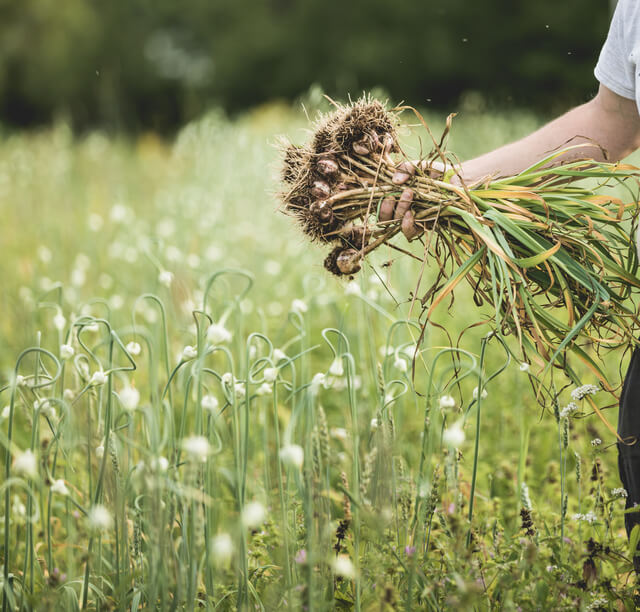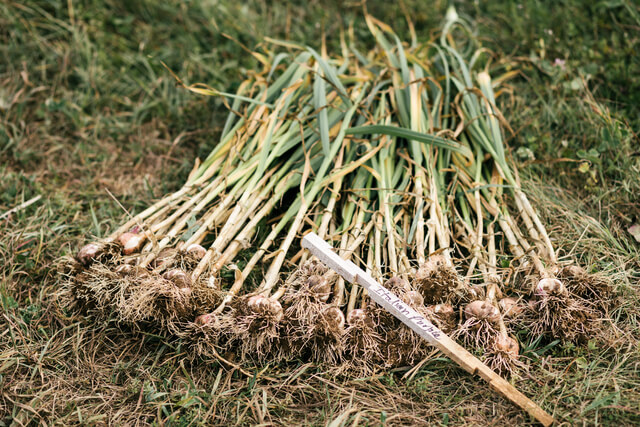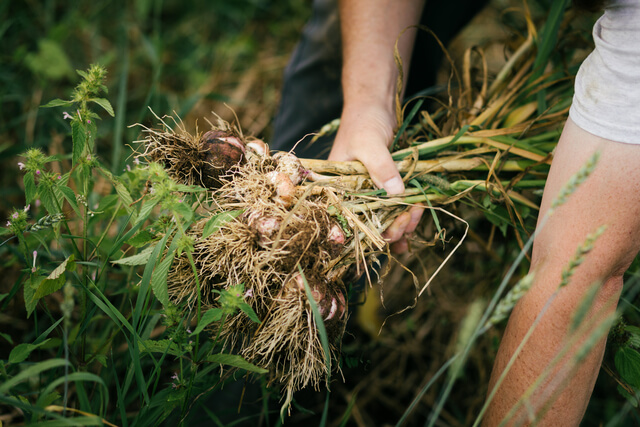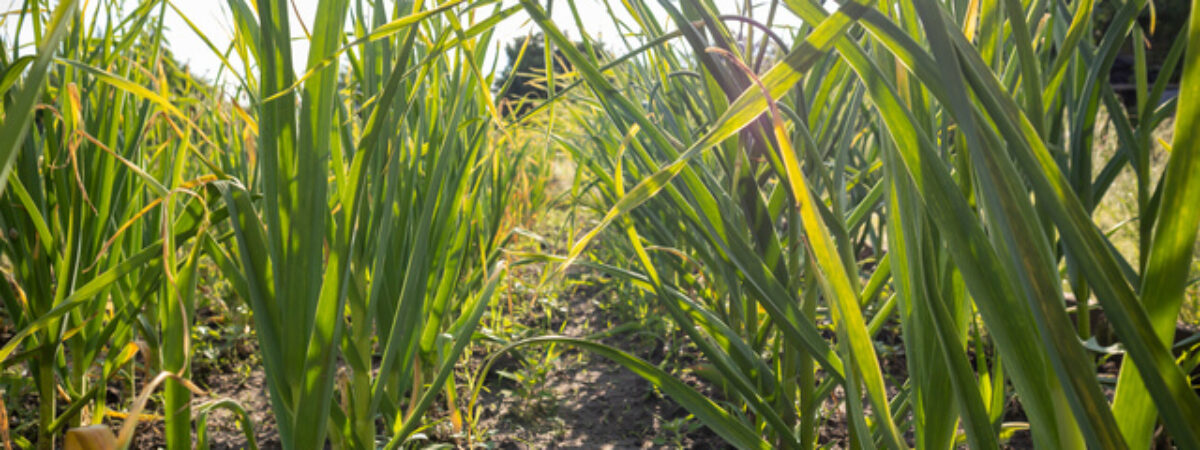Garlic is a bulbous perennial in the genus Allium, family Amaryllidaceae, with near relatives such as chives, leeks, onions, and shallots.
It develops to be 18-24 inches in height, with a storage organ in the head, or bulb, that stores fuel stocks in preparation for severe and chilly circumstances. Garlic is resilient in USDA Zones 4-9. It is suitable for a wide range of environmental situations.
The scented thin, grass-like leaves and segmented bulbs are commonly cultivated as an annual in herb and vegetable gardens.
Within a few months, hard-neck types produce a flattened, grass-like bloom stem referred to as a scape, which is accompanied by huge, umbel flowers. Soft Necks can also produce scapes on rare occasions. It is an Asian native.
Garlic must be planted around a month prior to the second frost in the autumn. Garlic picking isn't really an acquired skill. Click To TweetGarlic must be planted around a month prior to the second frost in the autumn. Garlic picking isn’t really an acquired skill.
It will develop gradually within the next 9 months or more, producing a large yield by mid-spring or summertime. Animals are known to be poisoned by garlic.
The umbels – or flower heads – unfold to display stunning, star-shaped blossoms in pink and white when left to develop. They encourage pollinators such as butterflies, bees, and ladybugs when they flower in late April.
On the tip of the scape, the seeds produce miniature bulbils that resemble mini garlic cloves. There will be no cross-pollination among various types grown alongside as those are genetically identical to the original species.
Even if you can produce from these seeds, the optimal way is to propagate from mature cloves, which has the potential to be successful and frequently results in larger bulbs.

Although garlic’s growth appears simple and uncomplicated, its distinctive flavor is powerful and nuanced, which is one of the reasons it’s used in practically every dish around the world.
On average, there are two types of garlic that are Softneck A. sativum or hardneck A. sativum var. ophioscorodon that has been discussed in this article.
Varieties
The sub-varieties are divided into two groups: hardneck and softneck.
Hardneck Varieties
The stiff main stalk, or neck, of hard neck , gives it its name. When compared to softneck bulbs, it generates fewer cloves.
The cloves are usually uniform in size and form a circle all-around plant’s crown. For northern producers, hard neck is the best option.The popular cultivars are Rocambole,Purple stripe and Porcelain
Softneck Varieties
The most common form offered in supermarkets is softneck, which moves and preserves well.
Softneck types thrive in hotter regions because they have a greater flavor and produce larger cloves.
Elephant garlic, which is more strongly related to leeks rather than real ones, is a good choice if you want a softer flavor. The popular cultivars are Artichoke and Silverskin
Growing Guide
Garlic, among the first crops to sprout in the spring, flourishes in well-draining, rich loamy soil and prefers sunshine to grow the largest bulbs.
Vernalization also called winter cold exposure is required for hard-neck types pre or post-sowing. Access to temperatures between 40 and 50 degrees Fahrenheit for 6 to 12 weeks throughout the colder months is optimum for bulb production.
Softneck cultivars are best suitable for growing in hotter regions, although they often benefit from a vernalization phase. Usually, the largest bulbs are produced by storing them in the fridge for 8-12 weeks prior to sowing.
To save time, select bulbs that have been chilled before at the nursery. As these will be able to plant when they arrive.
Cloves can be cultivated in the springtime or the autumn, but fall-placed garlic produces bigger bulbs with richer, extra nuanced flavors than spring-grown garlic.

Around most areas, autumn seeding is best in September and October, with the end of November being a common trimmed date for planting.
Because bulb production shuts down in hot temperatures and garlic takes a substantial growth period, springtime planting is not suggested.
If you need to plant in the spring, then have a limited moment of time in March if your regional weather allows it.
To plant the garlic, first separate the bulbs into separate cloves, keeping the papery layer around every clove undisturbed.
The larger cloves should be planted, while the lesser ones should be used for culinary or preservation.
To plant your garlic cloves, make holes about 2 to 3 inches deeper in the soil. Hole spacing should be 4 to 6 inches away. Click To TweetTo plant your garlic cloves, make holes about 2 to 3 inches deeper in the soil. Hole spacing should be 4 to 6 inches away.
If you’re growing in rows, leave 2 inches among each row. Less the spacing , lesser will be the bulb size.
Place the cloves 2 inches deeper, with the sharp tip pointing up and the basal/root end staring down at every hole.
Cover the planting hole halfway with topsoil and gently pat it down. 3 inches of mulch on top, slightly watered Garlic scapes should appear in around 6 to 8 weeks.
Caring Guide
Soil
Starting with nutritional soil is among the most critical aspects of raising garlic effectively. It ought to be humid yet drain well, and the pH must be between 6.0 and 7.0.
After sowing, cover the ground with a layer of mulch to protect the bulbs, retain moisture, and discourage the weeds infestation.
Light
Garlic is a light-loving plant, which is unexpected for a plant that grows largely beneath. Place the garlic in a location that receives full sunshine for at least 6 – 8 hours every day to give it the optimum capability to grow successfully.
Water
Garlic, due to its carefree character, does not require a lot of water. It prefers moist soil and needs about an inch or two each week, with a small increase if the temperature is particularly hot.
Keep the environment uniformly humid for the first 2 – 3 weeks of the planting period, then let it dry for two or three weeks prior to harvesting—mold can grow if grounds are too soggy at harvest period.
Temperature and Humidity
Garlic is a resilient plant that thrives in the cooler winter season. As a result, grow the garlic around a month prior to the first hard frost in the autumn.
Fertilizer
When it comes to cultivating garlic, fertilizer can be advantageous. As you grow your garlic in the autumn, add a slow-release organic fertilizer combination into the ground.
Finally, once the leaves turn to sprout in the spring, treat the soil around your plants with a nitrogen-rich fertilizer combination.
Harvesting
When most of the bottom foliage has turned brown, it’s ready to collect the garlic. This generally occurs in mid to late warmer months, but you might be ready to do it in the spring as well.
To check development, dig out a sample bulb or two—the garlic should be well-wrapped but not broken. Insert a gardening fork directly down into the earth, 6 to 8 inches away from the source, to collect.
The fork should be angled so that it passes beneath the bulb and raises it out of the soil. You don’t want to shatter the bulb by pulling it out by its leaves. Garlic scratches readily, so be careful.
Wipe away any soil that has clung to the bulbs. Wait for 2 to 4 weeks for the bulbs to heal or dry in a well-ventilated chamber or a dry, shaded area outdoors.

The tips and roots can be trimmed off after they have dried. Remove the skin shells of the bulbs to clean them even more thoroughly. Just make sure none of the cloves are exposed.
Garlic that has been picked prefers to be kept at relatively low temperature, as lower as 32 °F. Softneck types can endure up to 8 months if properly cared for.
In two or four months, hardneck cultivars may dry out, sprout, or become soft. Hard necks can be kept at 32 degrees Fahrenheit for up to 7 months without degrading.
Curing and Storing
Curing refers to the complete dryness needed for flavors to properly emerge, as well as ensuring a prolonged storage life free of decay and discoloration.
Garlic, on the other hand, can be eaten right after it’s been pulled. There’s no need to wait for the curing process to finish – just wash, remove the skin, and eat! Garlic that has been recently gathered has a lighter flavor than garlic that has been cured.
In the springtime, you may even pick out complete plants and consume the underdeveloped bulbs, which are similar to leeks.
This is known as “green garlic,” and it’s available at eateries and farmers’ markets. It’s a better substitute to bulb garlic. Both the leaves and the juvenile bulbs can be eaten.
When the coverings are dry and papery, and the roots are dry, the bulbs are dried and suitable to store. The root crown ought to be tough, and the cloves must be easily separated.
You can preserve the garlic bulbs once they have dried. Discard only the filthy wrappers, cut roots to 14 of an inch, and cut tops to 1 to 2 inches (do not wash).
Bulbs must be kept in a cold (40°F / 4°C), dark, and dry environment for many months after purchase. If it’s moist outside, don’t keep it in the basement. Garlic should not be kept in the fridge.
Conclusion
You may feel the incredible rewards, happiness, and enjoyment of having raised your very own blooms when you have fresh bulbs to enjoy right from your garden – and frequently, cultivating your own provides for many delicious and nutritious products!
What garlic-related gardening, cooking, or therapeutic experiences have you ever had?
Feel free to ask us any queries regarding garlic planting and growing in the comments section below.






